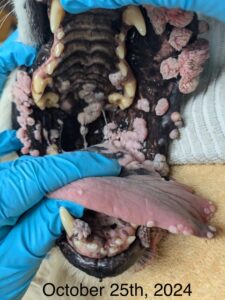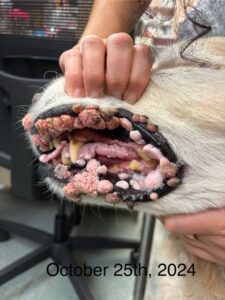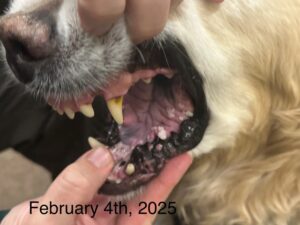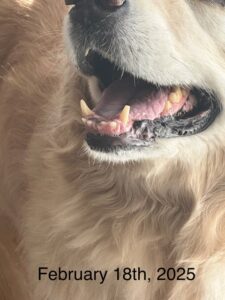Bentley is a 10yo MN Golden Retriever that was presented to the dermatology service for a consultation of refractory oral papillomas. Bentley comes in contact with several young dogs, and the owner reports that one of the dogs he came in contact with had oral papillomas that were self-resolving. In August of last year Bentley had a mass removal surgery for follicular cysts on his neck, and during that time the few papillomas in his mouth were crushed. Within 1 week of this procedure Bentley developed 50+ papillomas on his lips, tongue, buccal mucosa, hard palate, soft palate, nose, and chin and he was subsequently referred to dermatology. Bentley has no comorbidities and did not receive any immunosuppressive medications.



During Bentley’s initial consultation we proceeded with a sedated cryotherapy procedure. We performed 3 freeze-thaw cycles on as many of the papillomas that were accessible on the lips, nose, chin, and buccal mucosa. The papillomas in the remainder of the oral cavity were left untouched. Bentley was started on Azithromycin and topical Imiquimod. Due to the concern for the extensive oral distribution, lack of immunosuppressive medications, and significant worsening of the papillomas in a short period of time there was concern that Bentley’s immune system was not recognizing the virus. We discussed pursuing treatment with the new recombinant canine oral papillomavirus vaccine produced by Georgetown University and 2.5 weeks later the 1st of 5 vaccines were given. Bentley received the vaccine every 2 weeks for 5 injections total (10 weeks of treatment). By the time Bentley had his 3rd injection there was at least a 50% reduction in the number and size of his papillomas.

Bentley achieved complete remission 12 weeks after his first papillomavirus vaccine injection.


Canine oral papilloma virus (COPV, CPV1) causes oral papillomatosis. COPV is transmittedby direct and indirect contact with an incubation period of 1-2 months. Infection occurs at a site of damaged skin or mucous membranes. In general, COPV is usually self-limiting and will resolve in 3 months. Development of cell-mediated immunity by the infected host is required for papilloma regression. Young dogs with exposure to large numbers of other dogs at dog shows, dog day care, or at dog parks are at increased risk for infection.
COPV lesions may involve the oral cavity, lips, nasal planum, conjunctiva, haired skin of the face, and cornea. Lesions begin as multiple smooth white papules or plaques and progress to cauliflower-like masses. Anecdotally, dogs treated with immunosuppressive doses of cyclosporine, Apoquel (oclacitinib), glucocorticoid therapy, or cancer chemotherapy have developed lesions in adulthood. Discontinuation of the medications often results in resolution.
For treatment of COPV lesions that do not regress as expected, surgery may be curative for persistent solitary lesions. Care should be taken intra-operatively to avoid seeding the surgical site with viral particles. Cryotherapy and laser ablation are often effective, but may require several procedures. Use of interferon has been variably effective.
A new recombinant canine oral papillomavirus vaccine produced by Georgetown University Medical Center shows promise for treatment of refractory canine oral papillomas. The laboratory was involved in the production of Gardasil, the preventive vaccine for human papilloma virus (HPV). The vaccine consists of the major capsid protein L1 of the COPV. In one published report, oral papillomas regressed completely by the time the last injection of the COPV-L1 vaccine series was administered, and lesions had not recurred after 60 months of observation. One developer of this COPV-L1 vaccine, Hang Yuan, has subsequently treated 19 dogs with COPV L1 vaccine. In total, 31.6% had progression of lesions, 21% had stabilization of lesions and 47.4% had total regression of lesions without recurrence. Overall, 2/3 of the treated dogs responded. In those that did not respond, he speculates they had a specific immunodeficiency preventing adequate immune response or lesions that did not respond had already undergone malignant transformation to squamous cell carcinoma rendering the tissue not responsive to the antiviral vaccine . The most widely used application of this COPV L1 vaccine produced by his laboratory is for large dog groups where the risk of infection is high due to close cohabitation. The vaccine has resulted in 99% prevention of infection with papillomavirus.
Authored by: Tyler Charbonneau, DVM, Practice Limited to Dermatology